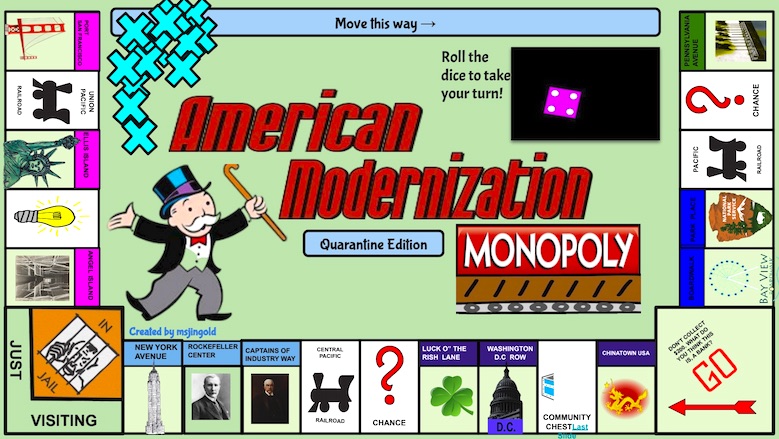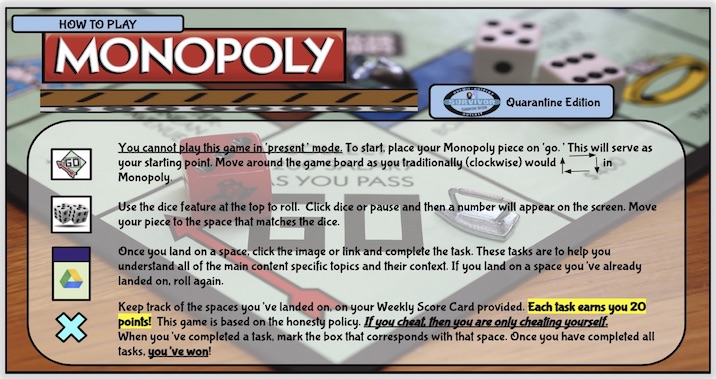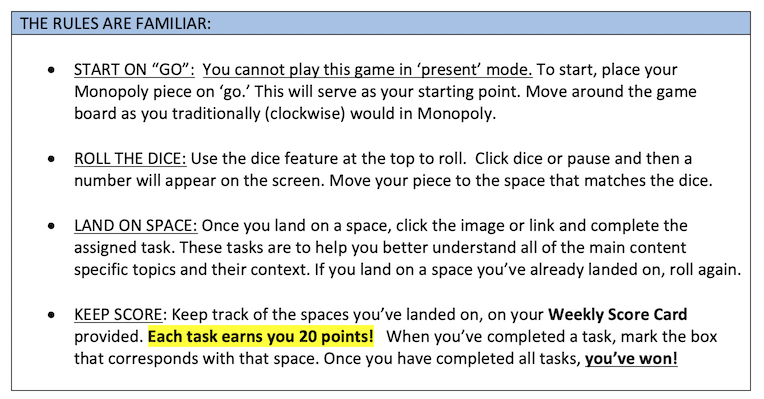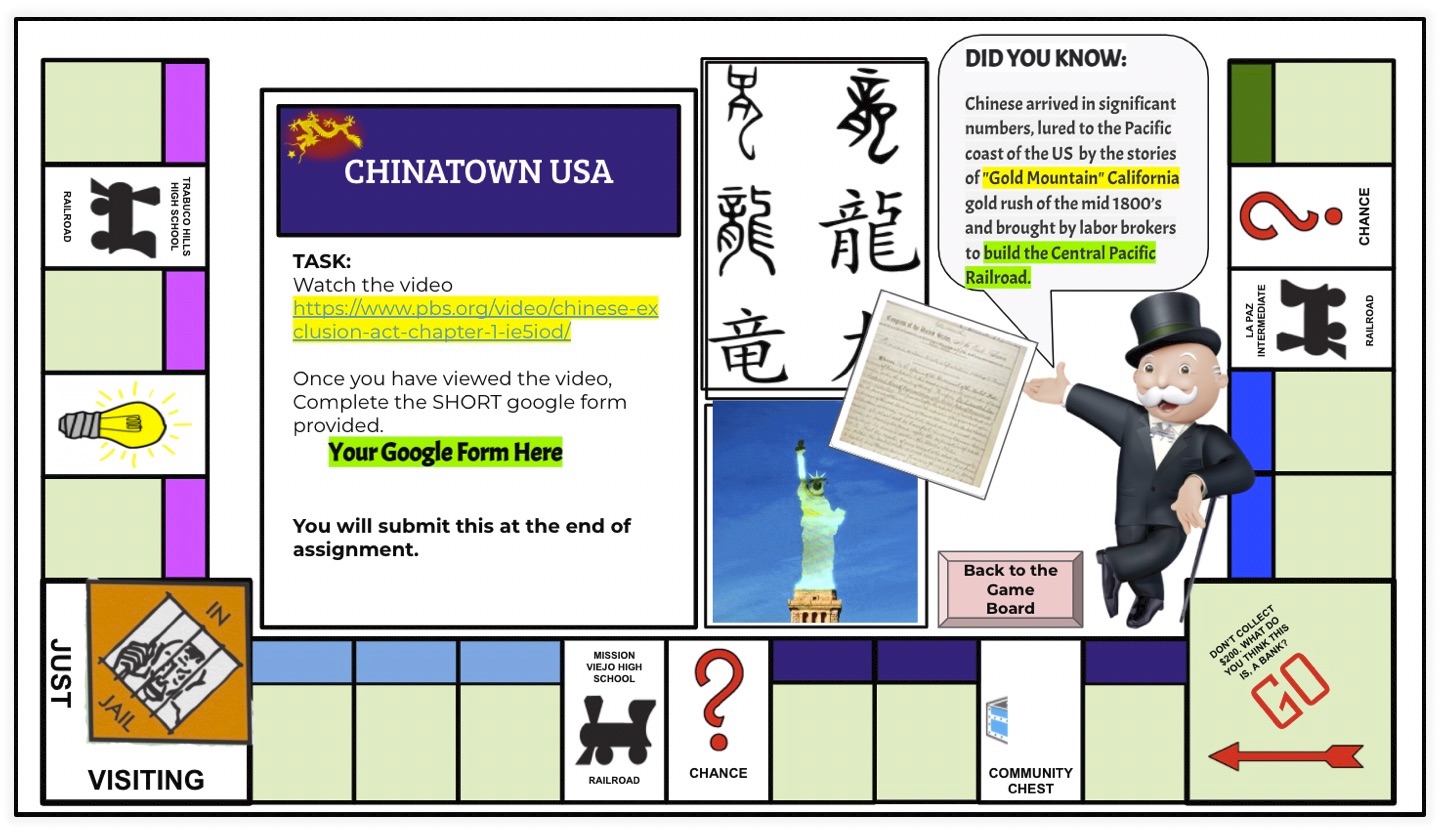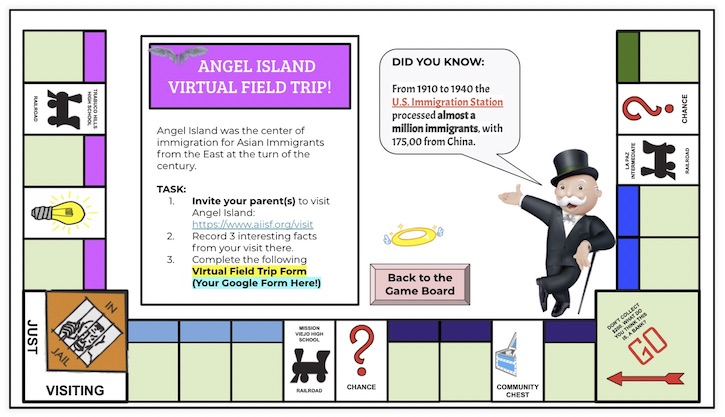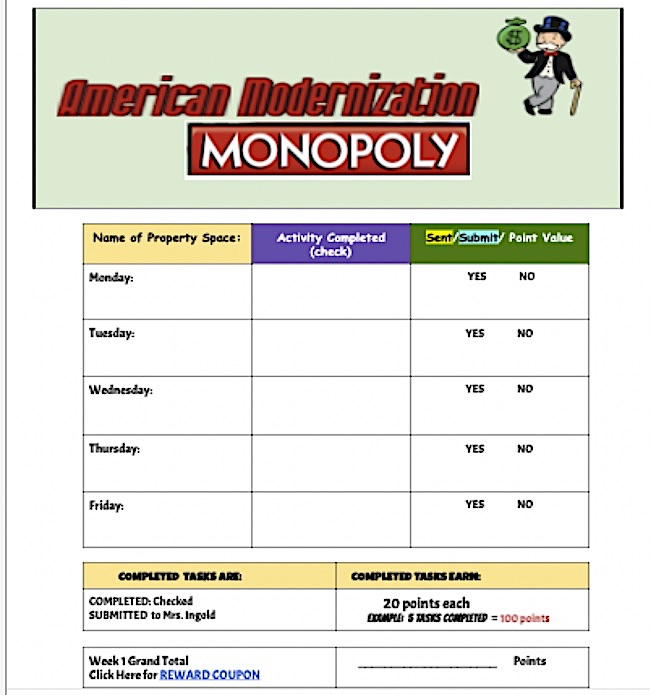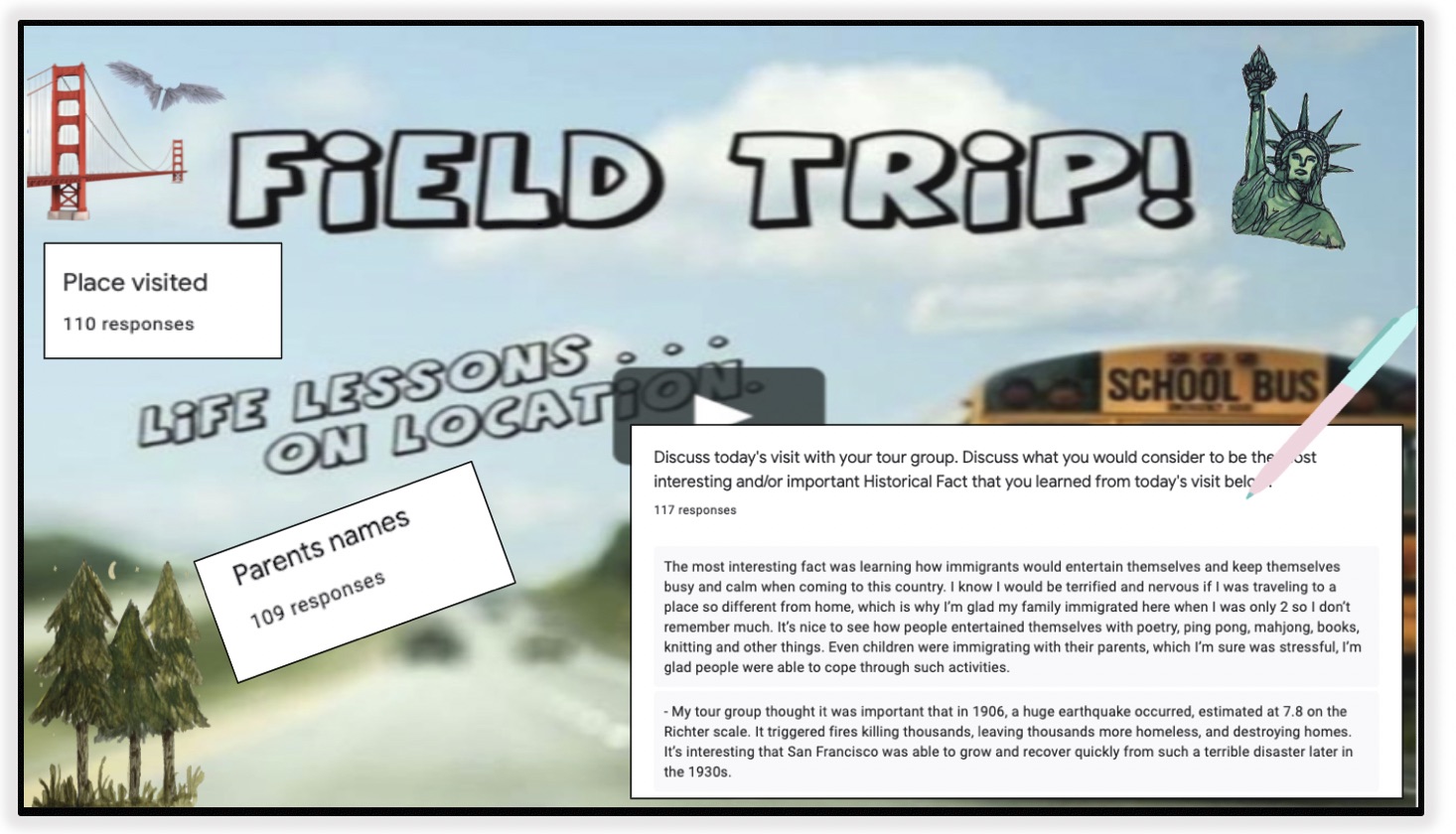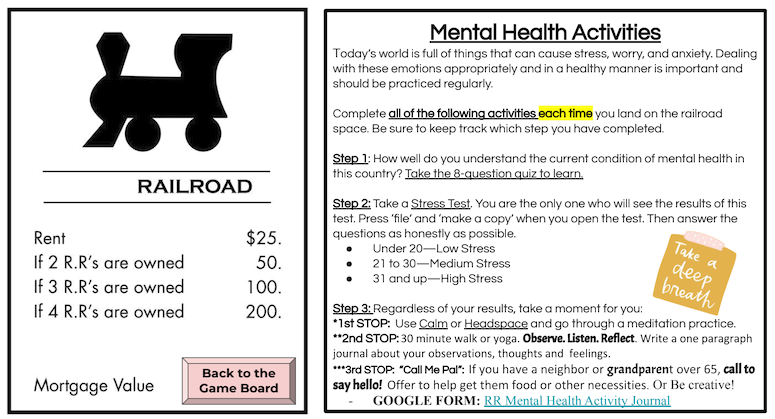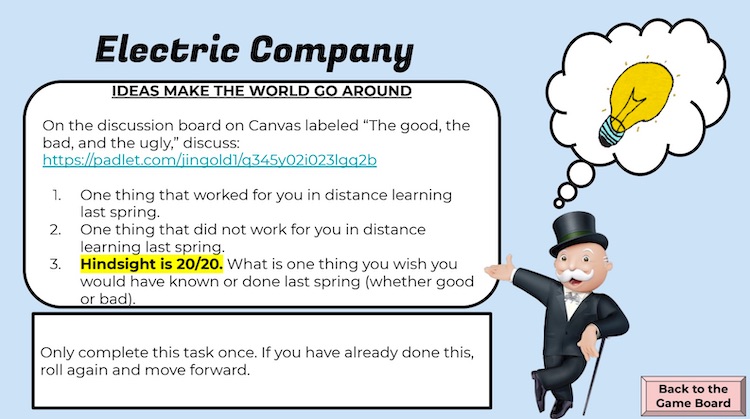Try a Game Strategy to Engage Kids in History
How do children really learn best? And, what can these experiences teach us about how to best assess and connect with students of all ability levels in a virtual learning world?
I designed the American Modernization Monopoly Game: Quarantine Virtual Edition to engage and assess my online history students as they learn about the Rise of Modern Industrial America. The simple and familiar structure involves tokens, virtual dice, a playing board and embedded links to “task cards” that promote historical inquiry.
I think this gaming approach to learning is an idea that can be easily adapted to other content areas. Now, let’s get reacquainted with our inner child. Got game?
Games are a perfect medium for learning
“Games are super-engaging and popular for everybody,” says Valerie Shute, a professor of educational psychology at Florida State University and an expert on games and learning. Their processes extend “across all gender, ethnic and socioeconomic lines,” she notes, making them an accessible education medium for all students and families.
Research further suggests games complement SEL by triggering significant emotions among the players as they develop thinking skills and deepen content learning. In fact, Nicholas Bowman, a professor of media and communication at Texas Tech University, discovered “as many as 75% of gamers had feelings of introspection and self-reflection during game play, even in games geared only for entertainment.”
In short, games can collectively be a powerful, purposeful, and fun learning experience. Are you ready to play?
Playing with a purpose: Game design
Games and game playing can have an extraordinary impact on teaching and learning. The key is in the selection and purposeful nature of the game design.
The game should be familiar, rules should be simple to follow, and there should be clear content and context goals. The game should offer tangible rewards and satisfaction that students can relate to – ensuring that “element of fun” that drives intrinsic motivation.
Our American Modernization Unit (link to all the graphics) was created by combining four separate content related topics into one synchronized unit where students could learn about their interconnectedness while experiencing how they relate in the real world.
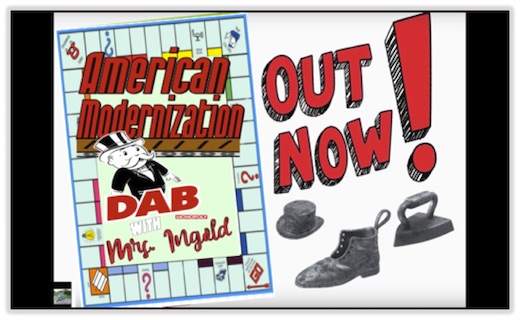
Built around compelling questions
The American Modernization Monopoly Game is an authentically designed classroom experience developed to creatively engage and formatively assess students as they learned about the causes and consequences of the Rise of Modern Industrial America.
Each of the game’s four topics has its own Compelling Question, and the game ends with two Compelling Closure questions:
Topic 1: Transcontinental Railroad
CQ1: How did the Transcontinental Railroad challenge the course of human history?
Topic 2: Rise of American Industry
CQ2: Did the evolution of American Industry change the course of human history MORE positively or negatively?
Topic 3: Immigration
CQ3: Did American Immigration challenge the development of American culture and society more on a social or political level?
Topic 4: Progressive Era Reform
CQ4: How did the rapid industrialization of America and the changing role of women generate more positive progress or negative challenges for turn of the century America?
Compelling Closure:
1. What was the greatest issue that identified the American experience in the early 1900’s?
2. Were the consequences for American culture and society during the Age of Modernization more positive or negative?
What’s your play? Earn while you learn.
The structure is simple. Students choose a token then roll the virtual dice to move around the board. Once they have landed on a space, they click on the link provided, which brings them to a formative task card. Each task card is content specific and contains activity information that is designed to maximize student engagement and promote historical inquiry:
Students keep a running record of their gaming experience and completed tasks through journaling them on their American Modernization Monopoly Weekly Score Card.
For every 100 points earned, students then submit a Google Form reward coupon which entitles them to choose how they would like to “spend” their points. Rewards include:
1 Free Homework Assignment, 5 quiz points, 10 test points or choosing to bank points toward a mystery Grand Prize. Once they have completed every task on the board, they have achieved “Monopoly” status.
Challenge, motivation, inclusion and immersion
How can educators seriously enrich any classroom through the inclusion of gaming? Game-based assessment has great potential to make learning less stressful and a more formative learning experience for all students. This not only challenges students, it promotes full engagement and real learning:
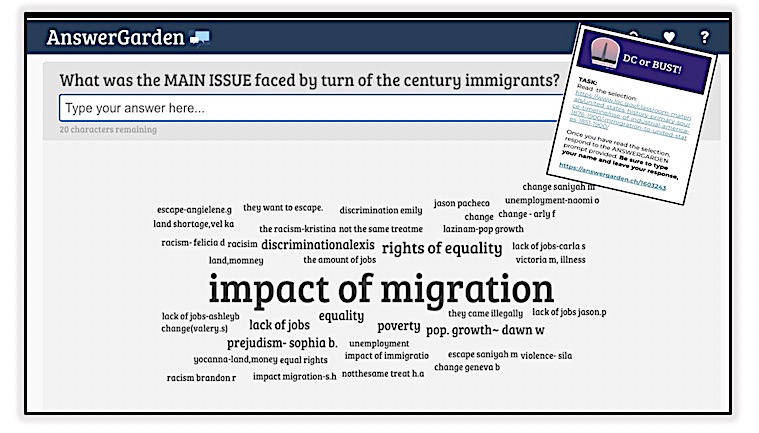
American Modernization Monopoly was also designed to increase participation between players and their families and promote a sense of community through completion of “shared tasks.” In addition to teaching content and curriculum objectives, students invite friends and family to also participate in the game through activities like “Ride Along” Tour Groups on Virtual Field Trips:
A student’s game experience is further enhanced through these shared learning opportunities by keeping the lines of communication open and helping to address concerns currently surrounding both student and family mental health needs:
Mental Health Journal Statistics
Games can be crafted in ways that measure student learning as they play – a technique Valerie Shute calls “stealth assessment.” And this can be done creatively.
Educators need to be mindful of how they are systemically tracking a student’s progress. Structuring this awareness is key to how to best improve upon and address individual student learning needs.
For example, having students consistently complete and submit some type of tangible formative assessment gives educators a running record of every move students make, while providing consistent motivation for them to track their own progress as they play.
While every task can be informally assessed by the teacher, it also provides students with invaluable opportunities for detail orientated self-assessment and reflection:
Hindsight 2020 – Student’s Padlet Reflection
The potential of games in our classrooms
Children learn best through familiarity, not memorization. Identifying learning gaps and guiding the successful immersion of games into our curricula are the keys to this strategy’s success. The organizational structure and fun familiarity provided by purposeful gaming is a natural complement to the educational process – giving students of all ages and abilities not just what they want but what they need.
“Games are the storytelling medium of the 21st century,” says Matthew Farber, a professor of technology, innovation and pedagogy at the University of Northern Colorado. “In my mind, why wouldn’t we teach with them?”
Link to Jennifer’s Monopoly graphics
References
Mock, Michelle. “Monopoly Board Template” SVUSD Monopoly-Dice Slides, July 2020.
Novotney, Amy. “Gaming to Learn.” Monitor on Psychology, American Psychological Association, Apr. 2015.
Oliver, M. B., Bowman, N. D., Woolley, J. K., Rogers, R., Sherrick, B. I., & Chung, M.-Y. (2016). Video games as meaningful entertainment experiences. Psychology of Popular Media Culture, 5(4), 390–405.
Pappas, Stephanie. “Games with Impact.” Monitor on Psychology, American Psychological Association, 1 Sept. 2019.
Jennifer Ingold (@msjingold) was chosen as both the NCSS and NYSCSS Middle School Teacher of the Year in 2019 and has received the Cohen-Jordan Secondary Social Studies Teacher of the Year Award from the Middle States Council for the Social Studies.
She currently teaches eighth grade social studies at Bay Shore Middle School in Bay Shore, New York. She has been a speaker at local, state, regional and national conferences, is a lead blogger for C3Teachers.org, and has had her work featured in major publications such as Social Education, Middle Level Learning, and AMLE Magazine.


